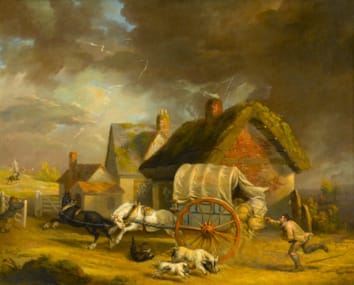
ames Ward
(London 1769 - Cheshunt 1859)
 Biography
Biography The Runaway Wagon
Biography
James Ward was an English painter and engraver. Many of his dynamic compositions depict horses, dogs or wild animals in agitated emotional states, the sense of movement being reinforced by vigorous brushwork and strong colours. With their sweeping landscapes and dramatic skies, his canvases epitomise Romanticism. Not content to excel merely as an animal painter, Ward also produced portraits, landscapes and genre and history paintings of varying quality. A prolific artist, he was a frequent exhibitor at the British Institution and at the Royal Academy, London.
Ward was trained as an engraver by his brother William Ward (1766–1826) and John Raphael Smith and was in great demand as a mezzotinter at the end of the 18th century and the beginning of the 19th when he translated into prints works by William Beechey, John Hoppner, Thomas Lawrence and others. He began working in oil around 1790. Ward’s painting career is traditionally divided into two phases, with 1803 as the watershed: in the first period the influence of his brother-in-law, George Morland, is most evident, particularly in genre scenes of children and rustics; in the second the influence of Peter Paul Rubens dominates. In 1803 Ward painted Bulls Fighting, with a View of St Donat’s Castle in the Background (London, V&A) in emulation of Rubens’s Autumn Landscape with a View of Het Steen (London, National Gallery), then just recently acquired by Sir George Beaumont. His unsuccessful attempt to exhibit this painting and Liboya Serpent Seizing its Prey (lost) at the Royal Academy resulted in a rift with that institution; however, in 1807 he was elected an ARA. While the impact of Rubens on Ward’s development is well documented and was long lasting, this traditional division of Ward’s career oversimplifies the diverse influences, ranging from Classical art to Old Masters and contemporary painters, that shaped his highly eclectic style.
Shortly before 1810 Ward began painting portraits of thoroughbreds and blood horses. Among major early works in this genre, Eagle (1809; New Haven, CT, Yale Centre for British Arts) established him as ‘the first of English animal painters now living’ (Sporting Mag., 1811, p. 265). Placed in a landscape that seems to stretch to infinity, the horse exudes the power and force typical of Ward’s finest animal portraits. Similar works led to his being elected an RA in 1811, and many comparable examples followed. Of special note are Napoleon’s charger Marengo and Arthur Wellesley, 1st Duke of Wellington’s Copenhagen (both 1824; Alnwick Castle, Northumberland). These were undoubtedly painted as pendants; with the horses symbolizing their masters, the compositions comment on the conflict that pitted France against England.
In the 1810s and early 1820s Ward produced a number of major paintings. Gordale Scar (?1812–14; London, Tate Gallery), depicting a gorge in North Yorkshire, ranks as one of his most ambitious compositions. The dark brooding landscape, dominated in the right foreground by a white aboriginal bull and populated with a vast array of cattle and deer, is one of the finest visualizations of the Sublime, an aesthetic then enjoying widespread currency.
From 1815 to 1821 Ward spent much of his time painting the Waterloo Allegory (lost), a gigantic composition of 6.4×10.7 m commissioned by the British Institution. It was during this period that Ward suffered a number of personal tragedies, including the deaths of his wife and a daughter. The commission was the result of Ward winning the Institution’s competition for a design honouring the Duke of Wellington’s victory and the final defeat of Napoleon. The study for the painting (London, Chelsea Hospital) is clearly indebted to Rubens’s Triumph of the Eucharist over Ignorance and Blindness (1625–7; Madrid, Prado). Ward hoped to augment the money he received from the Institution by exhibiting the work privately in London with an entrance fee, a practice used to great advantage by such contemporaries as Benjamin West and John Singleton Copley. Derivative as it was of an outmoded artistic form, the completed allegory was neither a critical nor a financial success.
Although in the 1820s Ward created such successful and provocative compositions as The Deer-stealer (c. 1823; London, Tate Gallery), he became increasingly disillusioned with the art world. In 1830 he retired to a cottage in Cheshunt, Herts, with his second wife, but he continued to exhibit regularly at the Royal Academy and the British Institution.
Many works from the last several decades of Ward’s life have religious themes or contain overt moral messages; for example he used a series of 20 canvases, which ostensibly depict character and expression in horses, as a vehicle for commenting on the human condition (e.g. Confidence and Disappointment, both c. 1840). These are described in the catalogue of works shown by the artist in 1841 at his London residence. Ward wrote theological tracts and poetry that date mostly from this period. A stroke in 1855 ended his artistic career and forced him to seek financial assistance from the Royal Academy.










